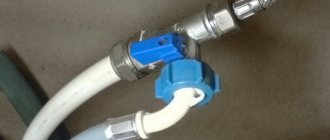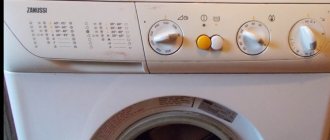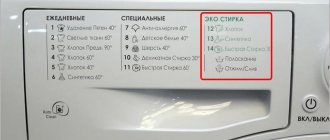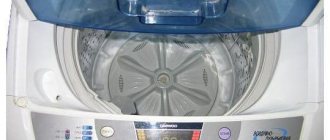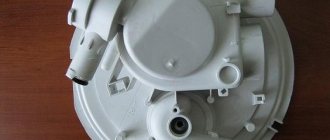Purpose and types of temperature sensors
The task of this element of the washing machine circuit is to control the temperature of the water in the tank. The sensor measures parameters in real time, transmits information to the control module, which in turn analyzes the data and, if necessary, gives the command to turn on the heating element.
Modern washing machines can be equipped with three types of sensors. Each of them has its own characteristics, advantages and disadvantages. These are: a bimetallic element, a gas-filled temperature sensor and an electronic thermistor sensor.
Bimetallic element
This is a purely mechanical device. The moving element of the sensor is a plate made of two metals, one of which has a significantly higher coefficient of thermal expansion. When the set temperature is reached, the plate bends and closes or opens the contacts.
Exactly the same element is used in irons, cheap convectors and other heating equipment with a temperature measurement function. The sensor is simple and fairly reliable, but has low accuracy and often fails due to oxidation of the contacts.
Gas-filled sensor
A temperature sensor of this type consists of a sensor itself with a sealed tube filled with gas, a temperature controller and a conductor that connects them. The sensor is installed in the tank; when the temperature changes, pressure arises, which acts on the membrane, closes and opens the contacts, turning the heating element on and off. Such temperature sensors are found in older Indesit washing machines.
This temperature sensor is distinguished by a fairly high accuracy of temperature measurement, but it is difficult to manufacture and prone to breakdowns. The slightest damage to the tube leads to a complete loss of functionality and the need to replace the sensor.
Thermistor
Unlike previous types, this is a completely electronic element. In modern washing machines, it has almost completely replaced mechanical parts. Found in almost all washing machines Samsung, Bosch and others. The temperature sensor is easy to change (it is installed directly next to the heating element). Structurally, it is a metal cylinder with a diameter of about 10 mm. There is a connection block for connecting to the wiring.
The operation of a temperature sensor is based on the effect of reducing its resistance when the ambient temperature changes. The absence of moving elements ensures a long service life, and electronic filling guarantees high accuracy of indicators.
How to check the temperature sensor of a washing machine?
To verify that a part is faulty, you will have to remove it.
Often the electronic thermistor is located inside the heating device, which is located at the bottom of the washing machine.
Checking the temperature sensor of a washing machine is not difficult. First you need to get it, and to get it you have to:
- remove the back cover;
- unhook the wires from the sensor;
- do not completely unscrew the screw that holds the heating element;
- get the thermistor.
A multimeter can show whether a part works or not. If it is already configured to determine resistance, all that remains is to hook the probes to the sensor contacts.
The multimeter should show a resistance of 6000 ohms if the temperature is 20 degrees.
Although the multimeter indicators are very conditional. You need to focus on the model of the washing machine:
- For Zanussi, Electroulux at a water temperature of 30 degrees, the resistance is approximately 17 kOhm.
- The temperature sensor of the Ardo washing machine will show 5.8 kOhm in normal mode.
- Kandy has 27 kOhm under the same condition.
Now you need to lower the thermistor into water with a temperature of 50 degrees and check it. The resistance should drop to 1350 ohms (depending on model).
To find out exactly what the indicators should be, you need to look at the description of the machine or the manufacturer’s website.
The thermistor cannot be repaired if it malfunctions. You will have to buy and replace the temperature sensor of the washing machine.
The gas-filled sensor is a little more difficult to get to.
You will have to remove the back cover and front control panel. On the control panel you need to unscrew the outer part of the sensor. On the back you should see a terminal with wires.
It is very important to avoid damaging the copper tube, so you will have to be very careful when removing the rubber insulation.
You can use an awl to pick up the seal around the tube and remove it. In order for the sensor to pop out of the groove, you need to press it a little, pull it out and unhook the wires.
A common breakdown for such a sensor is a problem with the copper tube from which the freon comes out and replacing the temperature sensor in the washing machine.
The bimetallic sensor is located in the same place as the gas-filled one, and is obtained in the same way.
It is checked with a multimeter followed by heating in hot water, as in the case of a thermistor. Basically, in such a sensor the reason for inoperability is in the plate, its wear or mechanical damage. If there is a malfunction, replace it with a new one.
There are external signs that allow us to say with confidence that the problem is in the sensor. These include:
- The machine even heats the water to boiling even in low temperature mode.
- The body of the machine heats up during operation, and steam is visible from the hatch.
Urgent repair or replacement will be required, otherwise it will fail, and more specifically, the heating element will burn out, which will hit your pocket hard.
We invite you to familiarize yourself with Essential oils for sweat odor
No matter how high-quality a washing machine is, sooner or later you have to repair it. Often there is a problem with water heating. It either stays cold or gets too hot.
Similar malfunctions are observed when operating models:
- LG;
- Indesit;
- Bosch;
- Candy;
- Ardo;
- Samsung and others.
When one of the device’s components fails, the corresponding code is displayed on the display indicating the cause of the failure. If you need to pay attention to the temperature sensor of the LG washing machine, it will display the tE code. If there is no screen, you can see the temperature indicators blinking.
Sometimes there are glitches in the LG control panel, which leads to an erroneous code being displayed. To check, turn off the power to the machine and then turn it on again. If the LG continues to show fault information, you will need to ensure that the connections between the control module and the electric heater are in place.
Often water does not heat up due to a broken temperature sensor. LG devices are equipped with thermistors. If the thermistor breaks, it is replaced.
Indesit machines are considered quite reliable, however, they can break down at some point. One of the advantages of Indesit is its self-diagnosis system, which allows the owner of the unit to independently determine the cause of problems and fix them without turning to specialists.
When code F03 appears on the display, you need to check the Indesit temperature sensor. If the model does not have a display, the lights light up or blink at the same time, as is the case with LG.
Lighted up sensors on the control panel
Reasons why this element does not work:
- The wiring that connects the temperature sensor and the control panel is damaged.
- The heating element relay has failed.
- A fault has occurred in the form of a short circuit/open circuit.
Any washing machine that has an electronic control module initially turns off and reboots. If such actions show that a normal failure has occurred, it is advisable not to refuse to contact the service center. Perhaps this way it will be possible to avoid further problems with Indesit.
From time to time, repairs are required for Ardo, Bosch, Samsung, and Candy machines. For example, Ardo can often overheat water, which causes damage not only to laundry, but also to various elements of the machine. You should be extremely careful if the water in Ardo boils. Overheating is often caused by a faulty thermostat or thermistor.
Owners of Bosch and Candy devices often call technicians to their home because the machine stops heating the water. The reason for this may be a breakdown of the heating element or a malfunction of the temperature controller. In some Bosch models, the thermostat is installed separately from the heater.
Experts say that it is necessary to regularly monitor the functioning of the washing unit. It should be examined twice a year. But there is no need to disassemble the machine unless absolutely necessary, in particular, this applies to checking the temperature sensor.
Water temperature sensors (thermal sensors) are installed in all washing machines, but their operating principle and design differ.
Thermostat is a temperature sensor in washing units with electromechanical control.
Thermostats are:
- bimetallic,
- gas-filled.
Thermistor is a temperature sensor in electronically controlled washing units. Most modern washing machines have thermistors.
Both the thermostat and thermistor measure the temperature of the water in the washing machine. The water is heated by a heating element (tubular electric heater).
When the water has heated to a certain temperature, the thermistor transmits a signal to the electronic module. The module, in turn, sends a signal to the heating element relay to stop heating the water.
The thermostat itself turns off the heating element relay and water heating stops.
Thermistors are in many ways better, more reliable and more durable than thermostats. If they do fail, another “plus” is discovered - this part can be replaced with a new one yourself.
Not every owner of a washing machine can repair or replace a bimetallic and gas-filled thermostat with a new one.
Failure of the heating element is the most common reason that the water in the washing machine does not heat up. Under normal conditions, the heating element is designed for a long period of operation, 5 - five or more years. However, hard water, low-quality detergents or failure to comply with the operating conditions of the washing unit lead to the formation of scale on the heating element. As a result of this, the heat transfer process is disrupted, the heating element overheats and burns out.
Electric heating elements are used in many household appliances: kettles, pressure cookers, boilers, etc. They can be dry or wet type. Dry heating elements do not come into direct contact with water or other liquid. Washing units from most manufacturers use wet heating elements.
R – resistance in Ohm;
Washing machine thermostat replacement tool:
- Phillips screwdriver;
- flat screwdriver;
- 10 mm socket wrench;
- tester;
- waterproof glue or silicone.
To replace the thermostat in your washing machine, you need to find out where the thermostat is installed. On most models it is located under the back cover along with the heating element (at the bottom of the drum). But, for example, on Bosh and Siemens machines the thermostat is located behind the front panel, and to dismantle it you need to remove the top and front panels. The installation location of the temperature sensor on your machine can be clarified in documents or on the Internet.
Sequence of operations:
- disconnect the machine from the network;
- drain the water from the tank;
- unscrew the screws and remove the cover;
- loosen the heating element fastening with a key;
- take a photo of the connection diagram before removing the power wires from the thermostat;
- carefully remove the thermostat with a flat screwdriver, being careful not to damage the rubber seal;
- remove the temperature regulator from the control panel;
- inspect the installation site and, if necessary, treat with sealant or glue;
- Install the new thermostat in reverse order;
- turn on the machine and check the operation of the thermostat in heating mode up to 40 degrees.
We suggest you read: How to choose daffodil bulbs and how to store them
Subsequence:
- disconnect the machine from the network;
- drain the water from the tank;
- remove the cover;
- loosen the heating element fastening with a key;
- take a photo of the connection diagram before removing the power wires from the thermostat;
- remove the thermostat;
- measure resistance with a tester at room temperature;
- Place the thermostat in hot water and measure the resistance again. If the measurement result does not change or changes slightly, the sensor should be replaced;
- installing the thermostat is done in the reverse order;
- turn on the machine and check the operation of the thermostat in heating mode up to 40 degrees.
Replacing the thermistor
Subsequence:
- disconnect the machine from the network;
- drain the water from the tank;
- remove the cover;
- loosen the heating element fastening with a key;
- take a photo of the connection diagram before removing the power wires from the thermistor;
- remove the thermistor, measure the resistance with a tester and compare with the nominal value for a given machine model;
- install and connect the new thermistor in the reverse order;
- turn on the machine, check the operation of the thermistor in heating mode up to 40 degrees.
Symptoms of a faulty temperature sensor
Most automatic washing machines from renowned manufacturers, for example, Bosch, can themselves detect a malfunction of the temperature sensor. If it breaks down, a code is displayed on the display, which allows you to accurately identify the source of the malfunction. In addition, the following symptoms indicate sensor failure.
- When performing any program, the water temperature rises to almost boiling.
- Body parts get hot, and in some cases steam appears in the area of the loading hatch.
- The heating element does not turn on, the washing machine does not heat the water at all.
The appearance of an error code on the screen, as well as any of the signs of failure described above, is a reason to start repairs. You should not delay, since a violation of the temperature regime entails not only damaged laundry, but also damage to a number of parts of the washing machine.
Replacing the washing machine temperature sensor
If your washing machine overheats and even boils the water, most likely the water heating temperature sensor - the temperature sensor - has failed.
A malfunction of the temperature sensor in some cases causes the opposite problem - the water does not heat up . Although much more often the cause of this trouble is a burnt-out heating element.
Whenever the water temperature in the washing machine does not correspond to the set temperature, it is checked and, in case of malfunction, replaced with a new temperature sensor.
How to check the temperature sensor and can you replace it yourself?
Partial disassembly of the washing machine
The temperature sensor measures the temperature of the water in the tank, therefore, it is attached to its body. To gain access to it, you will need to partially disassemble the washing machine. The easiest way to work is with new models in which the sensor is a thermistor; to check and replace it, just remove the back panel.
Before starting work, you must unplug the washing machine from the socket. Next, disconnect the inlet and outlet hoses. They need to be handled with care; there is probably some water left inside that could spill onto the floor.
The washing machine is moved away from the wall; it is better to place it in the middle of the room. The work is performed according to the following algorithm:
- Unscrew the screws holding the back wall;
- remove the panel, put it aside;
- loosen the screw holding the heating element;
- remove the temperature sensor.
This instruction is relevant in the case of a washing machine with a thermistor, these are new models Samsung, Ariston, Indesit and others. Finding and retrieving sensors in older washing machines has its own characteristics, which will be discussed below.
Reasons why the washing machine does not heat the water
There are many models of washing equipment and not all have the same sensor design.
They are divided into electromechanical ones, which are subdivided:
- bimetallic;
- gas-filled.
There are thermostats with independent decision making. Or they can be electronic - these are modern thermostats, called thermistors.
Their work is that they open the electrical circuit when the set temperature is reached.
According to their design, all thermostats used in washing machines can be divided into 2 groups:
- Electromechanical (bimetallic, gas-filled);
- Electronic (thermistors).
The first includes two types of thermostats, using different physical media, but based on the same principle - opening the electrical circuit at a certain temperature. Bimetallic devices are two plates fastened to each other, having different coefficients of thermal expansion. When heated, they bend and open the electrical contacts in the heating element’s power circuit.
Gas-filled thermostats use freon, which, when heated, increases in volume and puts pressure on a special membrane, which also opens or closes the contacts of the electrical network. There are electromechanical thermostats with a fixed or continuously adjustable response temperature.
Electronic thermistors are used in the most modern washing machines. The principle of their operation is based on the dependence of the semiconductor resistance on its temperature. A decrease in the resistance of the sensor is perceived by a special controller as heating the water, and at certain indicators it gives a command to turn off the heating element.
If, when the washing mode is set, which requires minimal heating of the water (up to 30 °C), it boils, first of all you should check the serviceability of the thermostat. Most likely, a failed sensor sends underestimated data about the heating temperature to the programmer, so it does not disconnect the heating element from the electrical network. In some cases, the culprit of the problem is a faulty washing machine programmer.
The main reasons for the failure of temperature sensors of this type are mechanical damage or wear of the bimetallic plates, as well as burning of the contact group. Because of this, the electrical circuit for heating water does not open even when it reaches a critical temperature. To check the serviceability of the bimetallic thermostat you will need:
- carry out incomplete disassembly of the washing machine;
- disconnect the wires from the temperature sensor terminals;
- measure the resistance at its contacts with an avometer (first at room temperature, and then heating the device in hot water).
If the thermostat is working properly, its resistance will vary significantly under different conditions.
Externally, a thermostat of this type resembles a small metal cylinder about one centimeter high with two terminals, inside of which there is a bimetallic plate. The upper part of the sensor is immersed in the washing machine tank and is in contact with water. To protect against leakage, the thermostat is placed in an insulating rubber cuff. To remove it from the tank you will need:
- perform partial disassembly of the washing machine;
- disconnect the wires from the sensor terminals;
- pry it up with a thin screwdriver or knife and remove it from the rubber seal, being careful not to damage the cuff;
Installing a new thermostat is done in the reverse order. To securely fasten the device in the hole, it is useful to coat its edges with glue or heat-resistant sealant.
An electromechanical gas-filled thermostat is larger than a bimetallic one and is a capsule with a diameter of about 3 cm. A copper capillary tube filled with freon is soldered to its inner edge, and the outer one is hermetically connected to the washing machine tank. The second side of the tube is connected to the actuator, which is responsible for opening the contacts.
The most common cause of failure of a gas-filled sensor is damage to the copper tube containing freon. As a result, the gas evaporates, and the contacts in the water heating circuit are constantly in the closed position. Such a temperature sensor cannot be repaired and requires replacement to be guaranteed to be in good working order.
Checking the serviceability of the sensor is carried out in the following way:
- using a tester, the resistance between its terminals is measured at room temperature to make sure that the internal contacts are closed;
- the sensor capsule is heated in any convenient way, after which a characteristic click of the contacts opening should be heard;
- After the temperature sensor cools down, its contacts should return to their original closed position.
We invite you to familiarize yourself with the expiration date of water meters
Most often, this type of thermostat is located at the bottom of the washing machine tub. It should be removed from the tank in the same way as a bimetallic one, but with extreme caution so as not to accidentally damage the capillary tube.
All relatively new washing machines use semiconductor thermistors to regulate and control water temperature. They are much more durable, reliable and accurate than electromechanical sensors. In addition, electronic thermistors are structurally simple, can operate under significant temperature changes, and are also resistant to mechanical loads.
To check the serviceability of the electronic sensor, you will need a thermometer and a tester configured to measure resistance. The operating instructions for the washing machine usually display the reference resistance values that the thermistor should show at different temperatures. It is necessary to heat it to the required value and measure the resistance.
If you suspect a breakdown of the temperature sensor, you must contact a specialist or figure out the reasons for the non-working state of the unit yourself. How to check the functionality of an element?
The easiest way is to remove the thermistor, since it is attached directly to the heating element. In many models, for example, Indesit, Samsung, temperature sensors are located at the bottom of the machine.
Removing the thermistor to measure its resistance before and after heating involves the following steps:
- After first turning off the power supply, remove the back panel of the washing machine.
- The contacts are disconnected.
- The fastening of the heating element is weakened.
- The sensor is removed.
Temperature sensor resistance measurement
Next, use a multimeter to measure the resistance of the temperature sensor of the washing machine:
- the tool used must be properly configured;
- multimeter probes are connected to the thermistor contacts;
- The temperature sensor is placed in water.
If the temperature sensor of the heating element is in working condition, a decrease in resistance is noted. It is important to remember that at 20 degrees the maximum allowable resistance level is 6,000 Ohms. The higher the water temperature, the lower the studied indicators should be.
How to check a gas-filled sensor:
- First of all, the machine is de-energized and the water is shut off.
- The front panel and rear wall of the unit are dismantled.
- The wires are disconnected.
- Usually in such thermostats the copper tube breaks, causing freon to escape. The solution to the problem is to replace the damaged sensor.
How to check a bimetallic thermostat? To get it, you will also need to get to the tank and disconnect all the contacts. For the test, a multimeter is useful, with which you can set the thermostat resistance. If it falls after placing the regulator in hot water, then the breakdown should be looked for elsewhere. Otherwise, the element is replaced.
A washing unit is a complex household device consisting of many elements. The reason for the lack of water heating may be a malfunction or breakdown of:
- heating element (heating element);
- water heating sensor (thermostat);
- programmer (electronic unit);
- water level sensor in the tank (pressostat).
Also, the water may not heat up enough when:
- incorrect connection of the washing unit to the drainage system, resulting in self-draining of heated water caused by the siphon effect;
- incorrect choice of washing program, in which the selected mode in favor of a higher temperature mode is ignored.
Thermistor check
The electronic temperature sensor changes resistance when the ambient temperature changes, this is exactly what you should make sure of. You need a multimeter to work. You need to do the following:
- disconnect the wires from the sensor;
- remove it from the socket;
- switch the device to the resistor testing position;
- check the resistance with a multimeter (the normal value at room temperature will be about 6 kOhm);
- lower the thermistor into hot water;
- re-measure.
At approximately 50 degrees, the thermistor resistance should be below 1.5 kOhm. If the value is constant or if the device shows a “gap”, the sensor is changed. Installation is carried out in the reverse order, the back wall of the washing machine is attached last.
If a breakdown is not detected, the cause of the malfunction may be a burnt heating element.
Types of thermostats
According to their design, all thermostats used in washing machines can be divided into 2 groups:
- Electromechanical (bimetallic, gas-filled);
Electronic (thermistors).
The first includes two types of thermostats, using different physical media, but based on the same principle - opening the electrical circuit at a certain temperature. Bimetallic devices are two plates fastened to each other, having different coefficients of thermal expansion. When heated, they bend and open the electrical contacts in the heating element’s power circuit.
Gas-filled thermostats use freon, which, when heated, increases in volume and puts pressure on a special membrane, which also opens or closes the contacts of the electrical network. There are electromechanical thermostats with a fixed or continuously adjustable response temperature.
Electronic thermistors are used in the most modern washing machines. The principle of their operation is based on the dependence of the semiconductor resistance on its temperature. A decrease in the resistance of the sensor is perceived by a special controller as heating the water, and at certain indicators it gives a command to turn off the heating element.
Removing and checking the gas-filled temperature sensor
Owners of an older Indesit or LG washing machine may encounter another type of sensor, the working part of which is a tube filled with gas. To remove and check such a temperature sensor, you will first have to dismantle the front panel of the machine and disconnect the regulator.
Further, along the wires coming from the regulator, it is easy to detect the sensor itself. It is mounted on the drum, but the exact installation location depends on the manufacturer and model; before starting work, you should read the disassembly manual for your specific washing machine.
To check this temperature sensor, you also need a multimeter. It is transferred to the “ringing” mode. Set the temperature switch to 45-50 degrees. The sensor is immersed in hot water and the moment of contact activation is recorded.
The faulty temperature sensor is replaced. Sensors and kits that also include a regulator are sold separately. It is better to change the pair, this will guarantee a long service life of the washing machine and protect against unscheduled repairs.
Types of temperature sensors
Water temperature sensors (thermal sensors) are installed in all washing machines, but their operating principle and design differ.
Thermostat is a temperature sensor in washing units with electromechanical control.
- bimetallic,
- gas-filled.
Thermistor electronically washing units . Most modern washing machines have thermistors.
Both the thermostat and thermistor measure the temperature of the water in the washing machine. The water is heated by a heating element (tubular electric heater).
When the water has heated to a certain temperature, the thermistor transmits a signal to the electronic module. The module, in turn, sends a signal to the heating element relay to stop heating the water.
The thermostat itself turns off the heating element relay and water heating stops.
Thermistors are in many ways better , more reliable and durable than thermostats. If they do fail, another “plus” is discovered - this part can be replaced with a new one yourself.
Not every owner of a washing machine can repair or replace a bimetallic and gas-filled thermostat with a new one.
Checking the bimetallic element
Sometimes you can encounter mechanical type temperature sensors; the procedure for checking them is similar to the procedure for working with gas-filled sensors, but the difficulty lies in finding and removing the element itself.
Exactly as in the previous case, the sensor is removed, tested for contact, and then immersed in hot water. By the way, a bimetallic temperature sensor can be checked without a multimeter. Due to its design, it clicks quite loudly when triggered, however, it is better to use the device; often the sensor does not trigger due to oxidation of the contacts, this cannot be determined by ear.
Despite the obvious complexity of a modern automatic washing machine, most of its breakdowns can be fixed independently. Replacing the temperature sensor is no exception. It is easy to check and replace if necessary. It is important only to buy original replacement sensors; an attempt to save money may become a reason for repeated repairs.




